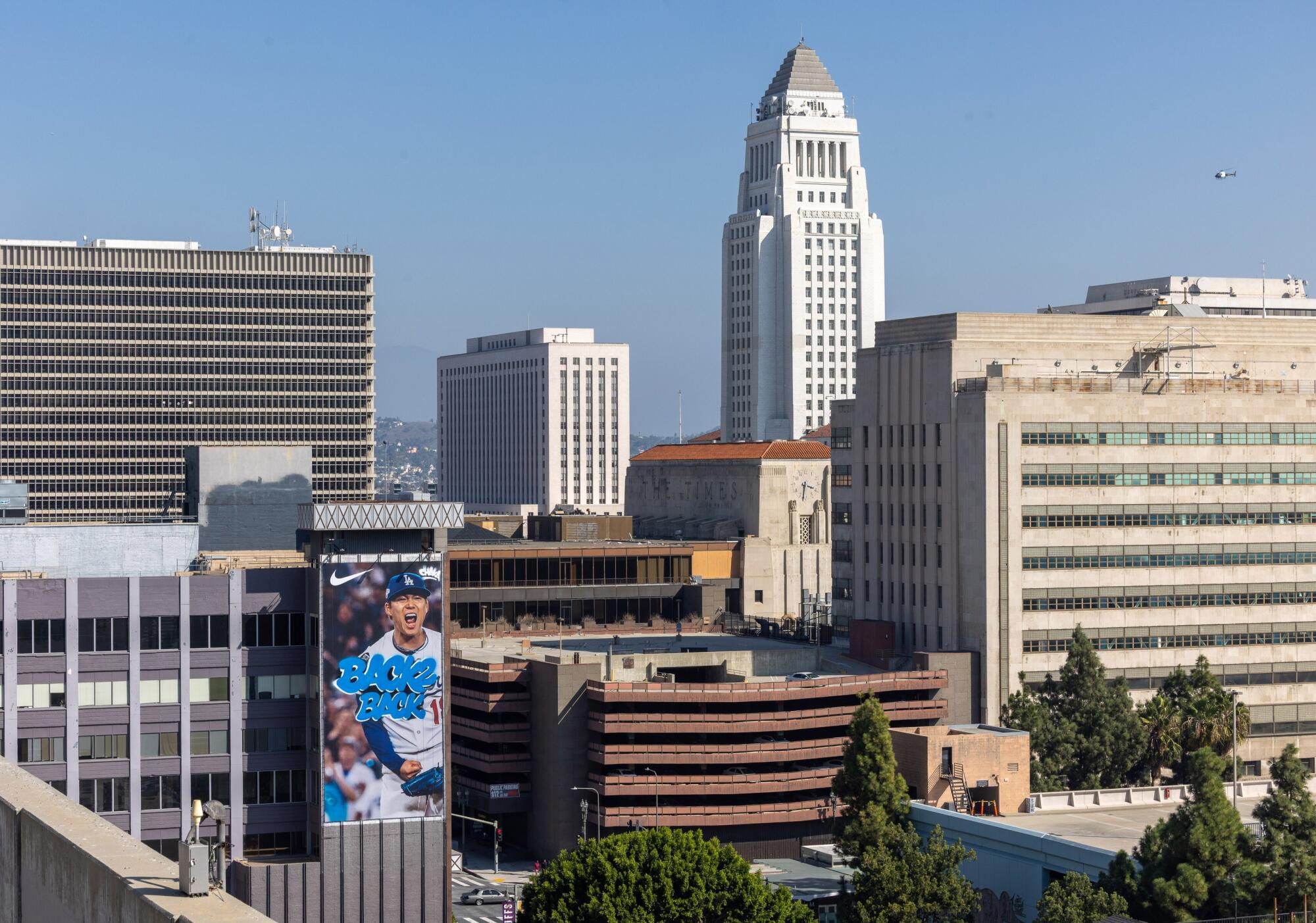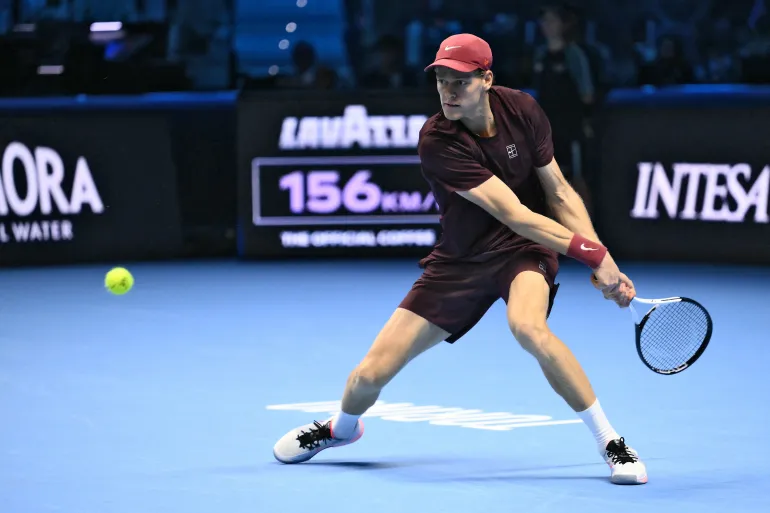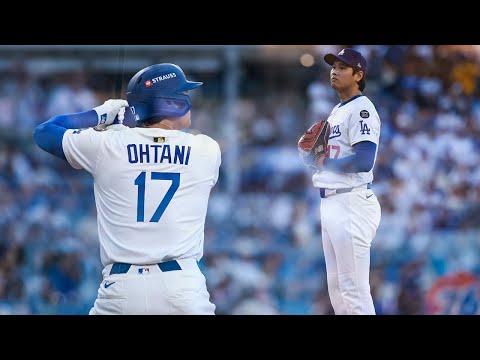‘Dodgers Rule’: Graffiti artist Chaka, others inspired by repeat champs
Legendary graffiti artist Daniel “Chaka” Ramos once claimed he had tagged more than 40,000 locations around Los Angeles.
He can now add seven more. And unlike decades ago — when Ramos had to sneak around in darkness to spray-paint his nickname in large, block letters all over the city and surrounding areas — this time it was fully permissible.
Earlier this month, Nike recruited Ramos to add his signature style to seven murals celebrating the Dodgers’ back-to-back World Series titles, which the team clinched Nov. 1 with a dramatic Game 7 victory against the Toronto Blue Jays.
Ramos, an L.A. native and Dodgers fan, was more than happy to participate, adding his name and slogans crafted by Nike to each piece. He told The Times in an email that it was his “first major project with a corporate giant like Nike.”

A mural of Dodgers pitcher Yoshinobu Yamamoto is a temporary addition to the downtown Los Angeles skyline.
(Natasha Campos / Nike)
“They’re one of the most prolific creative forces in the world, and collaborating with them was a milestone for me,” the 53-year-old artist said. “The rush of graffiti can’t really be compared to commissioned or gallery work, but this experience came close.”
The Nike murals, which are scheduled to remain up through Nov. 30, are among the pieces included in a new and quickly expanding online map detailing the locations of Dodgers murals in and around L.A. The map was created by and is curated by Mike Asner, the mastermind behind a similar website that documents the locations of hundreds of Kobe and Gianna Bryant murals around the world.
Asner already has a full-time job as a marketing director in sports and entertainment, as well as maintaining the Bryant mural site. Still, the morning after the Dodgers clinched their second straight championship, Asner knew it was time to get to start tracking more murals.
“I think the reception from the fans and the artists I got to know from the Kobe mural project was very positive,” Asner, who also has an Instagram page highlighting Dodgers murals, said. “And the main thing I realized was it was helping people and providing a service to them and making things easier. … After the Dodgers won back-to-back championships, we started to see murals going up immediately, so I felt it would be the right thing to do again.”
The map currently includes 54 murals, located as far north as Van Nuys and all the way down to Lake Elsinore. One of the standouts for Asner is a sprawling painting by artist Royyal Dog in the Florence-Graham neighborhood in South Los Angeles (2619 Firestone Blvd.). It features portraits of many all-time Dodgers greats, including Tommy Lasorda, Fernando Valenzuela, Orel Hershiser, Clayton Kershaw, Justin Turner, Yoshinobu Yamamoto, Mookie Betts, Freddie Freeman and Shohei Ohtani.

A sprawling mural by Royyal Dog in South Los Angeles features images of Dodgers greats past and present, including Yoshinobu Yamamoto (second from right) and Freddie Freeman (far right).
(Robert Gauthier / Los Angeles Times)
Another of his favorites is one by artist Gustavo Zermeño Jr. on the Eat Fantastic building in Redondo Beach (701 N. Pacific Coast Highway). A tribute to the 2024 World Series championship, the mural features Betts, Freeman and Ohtani but is highlighted by a larger-than-life image of Lakers legend Bryant wearing a basketball jersey with Dodgers colors and lettering.
The Nike-Chaka collaborations represent some of the newer artwork documented on Asner’s map. A Nike spokesperson said the idea was to give Ramos approved spaces in local neighborhoods to express the pride that Dodgers fans are feeling after back-to-back championships.
Two of the murals were painted directly on the walls by L.A.-based artists, with Ramos adding the slogans and his tag afterward. Artist Swank One painted the one at 2844 1st St. in Boyle Heights. It features relief pitcher Roki Sasaki and Smith embracing after the Dodgers clinched the National League pennant, with the slogan “On the Double.”

Graffiti artist Daniel ‘Chaka’ Ramos was commissioned by Nike to apply his tag to several temporary murals around Los Angeles celebrating the Dodgers’ back-to-back World Series championships.
(Natasha Campos / Nike)
Artists Enkone and Keorock painted at 4560 Whittier Blvd. in East L.A. The mural features pitcher Blake Snell, whose postseason included a one-hit, eighth-inning gem in Game 1 of the NLCS, with the slogan “Twice as Nice.” That mural has since been removed.
For four of the others, Nike licensed game photos from Getty Images, overlaid tag designs from Ramos and then had the images blown up and printed as murals.
Those include “Twice in a Blue Moon” in Silverlake (at Hollywood Boulevard and Hillhurst Avenue), featuring Max Muncy and Hyesong Kim; “Repeat Heroes” in Echo Park (at West Temple Street and North Boylston Street), featuring Smith and Sasaki; “Turn Two, Earn Two” in Echo Park (atSunset Boulevard and Marion Avenue), featuring Muncy; and “Dodgers Rule” — a play on Ramos’ longtime slogan “Chaka Rules” — in Westlake/Echo Park (at Beverly Boulevard and Commonwealth Avenue), featuring Sasaki.
The last mural features a photo of Yamamoto letting out a roar. The photo was blown up several stories high and installed several stories higher in downtown L.A. at 213 S. Broadway. Ramos then boarded a suspended scaffold and was lifted high above his hometown, where he spent four to five hours adding his tag and the slogan “Back 2 Back.”
It may not have been as daring as some of the stunts he pulled in the past, but Ramos definitely felt the rush.
“I’ve done graffiti at daredevil heights without a harness before, but nothing at this scale. This time I actually had to gear up with a harness — haha,” he wrote. “It was intense, but a lot of fun.”
The Nike-Chaka murals will be coming down soon, but Asner says he’s excited to see what other new creations might fill out the map in the aftermath of the latest championship run.
“We’re gonna see really amazing artwork going up, and we’re gonna see artwork of Dodgers that haven’t necessarily been on murals. like Will Smith and Yoshinobu Yamamoto,” Asner said. “There’s a lot of really big stars from this series that deserve to get credit for their amazing job. …
“You know, Ohtani was incredible, obviously, Friedman was incredible. But there were a lot of big players that stepped up — Miggy Rojas, right? Huge, huge reason they won. So it’s gonna be great to see what these artists do, and I’m looking forward to seeing it myself.”












